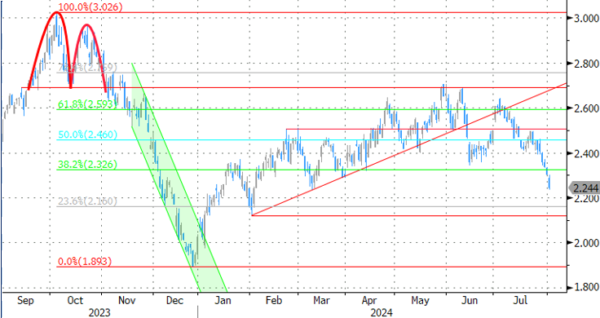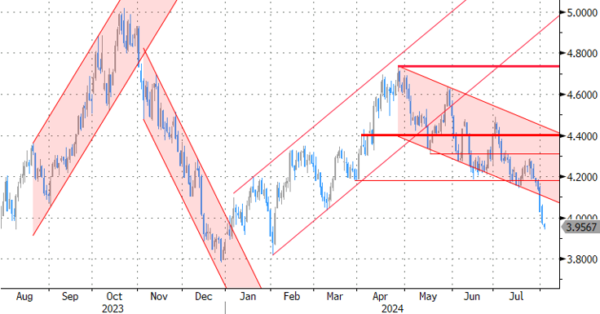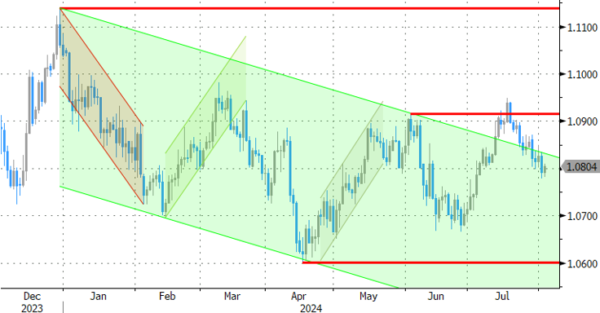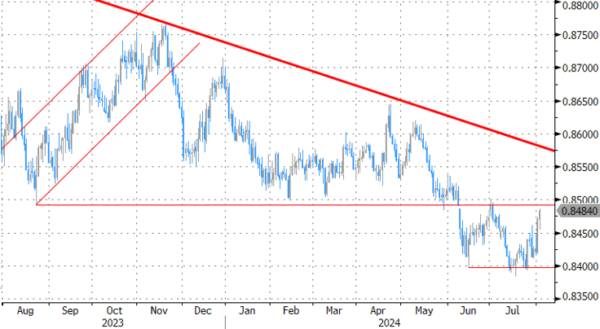Markets
And the summer slide continues. Core bond yields yesterday dropped another 2.7-10.8 bps in the US & 4.9-7.8 bps in Germany. The front outperformed after a series of US economic data disappointed across the board. Weekly jobless claims rose to the highest in 11 months, Q2 unit labor costs eased sharply to 0.9% and the manufacturing ISM hit a YtD low of 46.8 with subseries such as new orders (47.4) and employment (43.4) suggesting little improvement going forward. The numbers came after the Fed on Wednesday paved the way for rate cuts soon (September). With the central bank’s “go”, the front-end of the curve is now adjusting towards the estimated terminal rate. Market expectations are currently around <3.25% by end 2026. That’s a huge shift from just a month ago (>3.75%) but it is a more realistic view assuming the Fed is headed towards neutral (+/- 3%). Long tenors join the trend lower as the recent slew of sub-par eco data makes markets ponder the risks of a sharper economic slowdown than they had expected thus far. That’s also being reflected in stock markets. Both US and European equities are under selling pressure lately. Yesterday’s 2% sell-off meant the lowest close in the EuroStoxx50 since mid-February. The S&P500 and Nasdaq wiped out post-Fed gains to close back around the July lows. European yields suffer from US spillovers while economic data (e.g. PMIs) on the bloc were not very convincing either. Here, too, money markets have come to entertain a more realistic idea of an ECB terminal rate just north of 2% instead of >2.5% one month ago. US payrolls are in focus today. We don’t think they’ll alter current market forces. The US 2-yr yield is currently hovering near the YtD lows of 4.11%. A break looks imminent in case of a further moderating labour market. 3.95-4% is then the next reference to watch. After breaking sub 4.03%, the next technical zone to watch in the US 10-yr is located at 3.78-3.81%. Unless a dramatic payrolls report sparks outright recessionary fears, we don’t assume these levels to appear on the screens today. The dollar story is a nuanced one. UST outperformance yesterday was more than offset by the risk-off on equity markets, pushing EUR/USD eventually below 1.08 again. Similar trading dynamics could play out today. The EUR/USD 1.07 zone acts as first meaningful support. EUR/GBP jumped to 0.847 yesterday. Risk sentiment was yesterday’s main driver of GBP, outplaying the BoE and is probably going to be key for GBP today too.
News & Views
The Czech central bank cut policy rates yesterday by 25 bps to 4.5%. In the policy statement published afterwards, it noted that it still sees inflationary pressures in the economy. A restrictive policy stance is still deemed necessary and as such further rate cuts are approached “with great caution”. Headline inflation is expected to average 2.2% this year and 2% in 2025. Core inflation will still be at 2.3% next year. Its policy is working though and the CNB sees the economy below potential amid weak domestic and external demand. Czech GDP is expected to grow by 1.2% this year and accelerate to 2.8% next year on a recovery of household consumption. The forecasts are made on the assumption of a further modest decline in interest rates to around 4% end 2024/early 2025. The Czech crown, which appreciated yesterday from a 2.5 year low in the wake of the decision, is seen around current levels (EUR/CZK 25.3) for the remainder of the year before appreciating gradually through 2025.
South Korean inflation rose 0.3% m/m and picked up on a yearly basis from 2.4% to 2.6% in July, snapping a cooling streak that was in place since February. Core inflation matched June’s 2.2% y/y, defying expectations for a slight easing to 2.1%. While the Bank of Korea blamed temporary factors for the uptick and sees inflation resuming the downtrend this month, it remains wary for easing policy from the current 3.5% level. It is awaiting evidence for inflation to cool as expected (and sustainably to the 2% target) while they are worried that a less restrictive stance would prompt an increase in household debt. The South Korean won slightly gains this morning to USD/KRW 1370.
Graphs
GE 10y yield
The ECB cut policy rates by 25 bps in June. Stubborn inflation (core, services) make follow-up moves less evident. Markets nevertheless price in two to three more cuts for 2024 as disappointing US and unconvincing EMU data rolled in, dragging the long end of the curve down. After breaking below 2.34%-2.4% eyes now turn to 2.12-2.16%.
US 10y yield
The Fed in its July meeting paved the way for a first cut in September. It turned attentive to risks to the both sides of its dual mandate as the economy is continuing to move better in to balance. There was no pushback against market pricing back then (75 bps cuts in 2024, 100 bps in 2025). The pivot weakened the technical picture in US yields with another batch of weak eco data pushing the 10-yr sub 4%.
EUR/USD
EUR/USD tested the topside of the 1.06-1.09 range as the dollar lost interest rate support at stealth pace. A September rate cut is highly likely and markets increase bets on future easing on incoming weak US data. The risk-off these data trigger (sharper than expected slowdown?) offset the interest rate losses for USD. EUR/USD is moving south within the 1.07-1.09 range.
EUR/GBP
The Bank of England delivered a hawkish cut in August. Policy restrictiveness will be further unwound gradually and on a pace determined by a broad range of data. The strategy similar to the ECB’s balances out EUR/GBP in a monetary perspective. Risk-off proved a more important driver of GBP recently. We may see a return to the 0.85-0.86 sideways trading range that dominated 2024H1.













![Week ahead – ECB set to cut, BoC might pause as Trump U-turns on tariffs [Video]](https://www.actionforex.com/wp-content/uploads/2018/04/f-ecb29-218x150.jpg)




